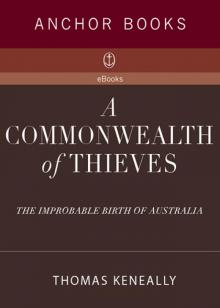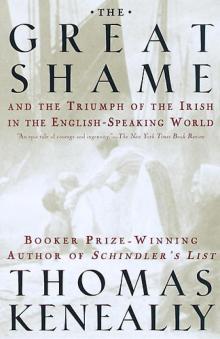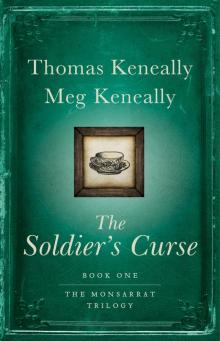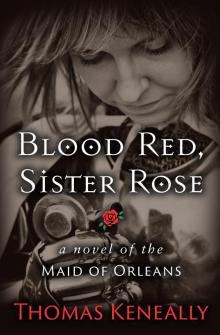- Home
- Thomas Keneally
Australians Page 8
Australians Read online
Page 8
In that last winter in England for the many convicts who would soon find themselves on Arthur Phillip’s departing fleet, one visitor noted that there were in Newgate many ‘miserable objects’ almost naked and without shoes and stockings. Women prisoners in the wards were ‘of the very lowest and most wretched class of human beings, almost naked, with only a few filthy rags, almost alive and in motion with vermin, their bodies rotting with the bad distemper, and covered with itch, scorbutic and venereal ulcers.’
To what extent did the urgency of the domestic prison problem cause government to be reckless? For was it not reckless to entrust not just one or two but eleven ships to a destination at which, as far as was known, only one other had ever sailed? Could the Home Office and the Admiralty be so sure of Arthur Phillip’s competence? In any case they began to see their project delayed specifically for that reason—Phillip’s competence. Such was his insistence that the ships be comprehensively equipped, they must have come to wish they had appointed a less fussy fellow. Lord Sydney and Nepean had no desire to create a penal catastrophe and did not want ships sunk or felons wiped out by scurvy, but they had envisaged the fleet would be gone by Christmas 1786. The early sight of convict vessels disappearing down the Thames estuary with sails set was the chief point for the Home Office, not how they fared from the instant of disappearance onwards.
FLASH TALK
While roughly half the convicts of Phillip’s flotilla of ships came from regional towns and the countryside, the other half were London convicts from areas north of the Thames River: Stepney, Poplar, Clerkenwell, St Giles and Seven Dials, Soho. (Only a minority came from the South London dockside regions.) In the tenements around St Giles parish, Soho—the famed Rookery of St Giles, also known as Little Ireland for its considerable population of displaced Irish—and in Spitalfields to the east, in squalor unimaginable lived all the classes of criminals. One observer would call the St Giles Rookery ‘a honeycomb, perforated by a number of courts and blind alleys, cul-de-sacs, without any outlet other than the entrance’. Another compared it and other criminal slums in London to giant blocks of stone ‘eaten by slugs into innumerable small chambers and connecting passages’.
London criminal classes were bonded together by devotion and oaths taken to the criminal deity, the Tawny Prince, duly honoured by theft, chicanery and a brave death on the gallows. And, of course, by the speaking of his language, ‘flash’ or ‘cant’, criminal co-operatives or gangs calling themselves ‘canting crews’. In flash talk or cant, a pal was a pickpocket’s assistant who received the swag as soon as the pickpocket had lifted it. A kiddy was the fast-running child to whom the pal further passed the swag. A beak was a magistrate, a pig a Bow Street runner. Tickling the peter was opening a safe, and a fence was a receiver of stolen loot. All these terms mean something to us now through their entry into mainstream English, but at the time they were incomprehensible not only to officers of courts but to the general law-abiding populace.
Cant appeared, amongst other places, in a flash ballad of the time which read:
I have a sweet eye for a plant,
And graceful as I amble,
Fine draw a coat-tail sure I can’t,
So kiddy is my famble.
Frisk the cly, and fork the rag,
Draw the foggles plummy,
Speak to the tattler, bag the swag,
And finely hunt the dummy.
A translation would read: I can spot an intended victim, and I have considerable practical skill in the craft of stealth. So I pick a pocket, take the cash, take fine handkerchiefs skilfully, steal a watch and pocket chains, and search for a pocketbook.
‘A leading distinction, which marked the convicts from their outset in the colony,’ wrote a military officer and friend of Arthur Phillip named Watkin Tench much later, when the convict colony was at last established, ‘was the use of what is called the flash or kiddy language . . . This language has many dialects. The sly dexterity of the pickpocket; the brutal ferocity of the footpad; the more elevated career of the highwayman; and the deadly purpose of the midnight ruffian is each strictly appropriate in the terms that distinguish and characterise it. I have ever been of the opinion that an abolition of this unnatural jargon would open the path to reformation.’
In London, the criminal classes availed themselves of many public houses in the City and Spitalfields that were centres for prostitution, the fencing of stolen goods and the division of plunder. ‘Hell houses’ or ‘flash houses’ were common names for such places. They were to be found in a number of notorious locations: Chick Lane, Field Lane, Black Boy Alley. Over their half-doors fleeing criminals were free to toss whatever they had plundered and were on the run with. A convict turned novelist would describe a criminal approaching a ‘fence’ in a house in St Mary Axe: ‘There was a box in the wall, so contrived that upon placing any article you wished to dispose of within it and ringing a bell, the box disappeared. After a lapse of a few minutes it again turned, and in lieu of the article left was a sum of money . . . the thieves of London much approved of the principle, as they were never seen by anyone while disposing of their ill-gotten booty.’
Such houses were the former cosmos of many of the men and women who would end in Arthur Phillip’s convict fleet.
PHILLIP TAKING PAINS
The Home Office had asked for a discreet officer, and got one. Arthur Phillip could smell disaster in the rushed agenda of his masters and he proved tenacious in his demands for a well-supplied fleet. He wanted the mass of the convicts to arrive at the nominated shore in good health. If he was rushed, they could not. In his little office at the Admiralty, Phillip worked with his clerk, the unkempt Harry Brewer, and as if to focus his mind, wrote a document (on many sheets of paper of unequal size) which represented his philosophy of convict transportation and penal settlement. Not as a visionary, but merely as someone acknowledging the state of British law, he noted: ‘The laws of this country will, of course, be introduced in New South Wales, and there is one that I would wish to take place from the moment His Majesty’s forces take possession of the country—that there can be no slavery in a free land and consequently no slaves.’
His determination that convicts not be seen as a slave caste would have important results for many of the felons marked down for his convict transports. He had respect for their right to as safe and healthy a journey through the mirror as he could provide. But he did not see their ultimate status as fully equal to that of the free. ‘As I would not wish convicts to lay the foundation of an Empire, I think they should ever remain separated from the garrison and other settlers that may come from Europe.’
Through secret caresses between free men and convict women, and other alliances forged on his ships, this would become a proposition already in doubt before the ships even sailed. The successful tenderer for the overall contract for the fleet was a man named William Richards Jr, a prominent ship-broker of South London. The story goes that contractors dumped their worst produce on Phillip, knowing he could not very conveniently complain. But two reliable young officers of marines, Watkin Tench and David Collins, no strangers to salt rations, would independently agree that the provisions on the First Fleet provided by Richards were ‘of a much superior quality to those usually supplied by contract’. Though we have no similar enthusiastic endorsement from any convict, the low death rate during the flotilla’s months of voyaging would suggest that Phillip, when visiting the vessels up the Thames at Deptford, and Richards himself, must have been careful at their inspections of barrels of salt beef and pork and flour.
Richards had put a lot of thought into convicts: their quarrels when they had to sleep together four to a berth—he unsuccessfully suggested individual hammocks; their jealousy when some dressed better than others—he thought there should be a standard uniform; the influence which the wicked exercised over the others—he suggested there should be three classes of felons sent on separate ships. Richards would have preferred an intermediate place o
f transportation at Milford Haven in Wales, with only the worst convicts being sent on to New South Wales.
Indeed Richards was conscientious to the point of crankiness. Under his contract with the Navy Board, he had gone on the river and inspected and chartered five merchant vessels as transports—the Alexander, Charlotte, Friendship, the newly built Lady Penrhyn and Scarborough—and three store ships: Borrowdale, Fishburn and Golden Grove. The contracts with the shipowners were called charter-parties and were specific about the duties of the shipowners and captains, the number of crew per tonnage, and the form of accommodation, rations, cooking equipment, bedding, fetters, ventilation equipment and so on supplied for the convicts, and the medicines and medical preventives to be taken aboard. Ultimately, as the number of convicts loaded on the ships grew, Richards would need to contract a sixth convict transport, the Prince of Wales. The transports were all relatively young vessels, but not purpose-built prison ships, so they required special fitting out by carpenters at the Deptford dockyard in order to be able to receive prisoners on their cargo decks. All were three-masted and over 300 tons (306 tonnes), except the Friendship, a 278-ton (284 tonne), two-masted vessel generally described as a brig or a snow.
For Richards and the individual shipowners the cream from this expedition would come after the ships finished off the business of taking the convicts into the void. Some of them looked to receive further charter from the East India Company, authorising them to go to China to load tea. Richards depended on Lord Sydney to apply pressure to the East India Company directors, who exercised monopoly over East Asian trade, and ultimately the company would take up three ships—Charlotte, Scarborough and Lady Penrhyn—to bring a cargo of tea home from China. That was if they reached Botany Bay in the first place.
Arthur Phillip could not be in Deptford all the time, but the navy had appointed an agent to represent him and it at the dockyards and see that the necessary carpentering was competently done, and all arrangements were properly made for receiving prisoners. The convict prison on each of the ships was fitted out on the lowest cargo deck, where cradles—narrow sleeping bunks in sets of four or six—ran the length of the ship on either side of an aisle. Young Lieutenant Philip Gidley King, Phillip’s protégé from Europe, was down at Deptford attached to Sirius, and described the sort of security being put in place on the transports. He saw that the carpenters were barricading an area on deck with a wooden barrier about 5 feet (1.5 metres) high, and topping it with pointed iron prongs, ‘to prevent any connection between the marines and ship’s company, with the convicts. Sentinels are placed at the different hatchways and a guard always under arms on the quarterdeck of each transport in order to prevent any improper behaviour of the convicts, as well as to guard against any surprise.’ Below, to contain the prison deck, thick bulkheads were positioned, ‘fitted with nails and run across from side to side [port to starboard] in the between decks above the mainmast, with loop holes to fire . . . in case of irregularities’. Forward of the prison space was the prison hospital, and the equally dark areas aft of the prison were often reserved for marine privates and noncommissioned officers and their families.
The hatches which gave onto the deck were ‘well secured down by cross bars, bolts and locks and are likewise nailed down from deck to deck with oak stanchions’.
The barricaded area on the open deck gave the authorities a place where even the most unruly convicts could be exercised, but many knew that in such close quarters the barriers might in some ways break down, and that there would be contact of various kinds, including sexual contact. For the transports were all very intimate in their dimensions. The largest of them was Alexander, 114 feet (34.7 metres) in length and 31 feet (9.5 metres) in breadth, barely more than the width of a decent parlour, and a mere 450 tons (459 tonnes) burthen. On the lower decks no one but a child could stand upright—the prison deck of Scarborough, for example, was only 4 feet 5 inches (135 cm) high. The seamen’s and soldiers’ quarters had similar limitations.
Already, in Whitehall in dismal winter, nameless clerks were attaching the lists of convicts’ names to the orders-in-council that authorised transportation. There were no selection criteria for transportees based on health, suitability, trade or sturdiness. A convict of any age, strength and skills could go to Botany Bay. Time already served meant nothing to the bureaucrats either. In some cases the clerks attached the names of convicts who had served five years of a seven-year sentence.
These orders and lists were sent to the keeper of Newgate, to the Clerk of Arraign at the Old Bailey, and the hulk overseer Duncan Campbell. The fitting out of the transports finished, the ships moored at Woolwich, and the first convicts, men and women from the hulks and Newgate, and from some county prisons, were rowed down the wintry river to the Alexander and Lady Penrhyn on 6 January 1787. Many of them were sick and clothed in rags when received on deck in their prison irons. These were struck off their wrists by a crew member and then the ship’s chains were put on, and the transportees descended to the sharp cold and pervasive damp of the prison decks. Down in the chill dimness the convicts were often secured in place by chains which ran through an ankle shackle on each convict. Some masters wanted the prisoners wristlet-ed as well. As yet the convict decks had empty spaces, but the allotted space per felon, when fully loaded, was 18 inches width by 6 feet in length (46 cm × 1.8 metres). The waste arrangements were a series of buckets aft, topped by a plank with holes cut in it.
Even on Lady Penrhyn, reserved for women, the master kept the prisoners handcuffed and chained and below decks in those first days, purely out of fear. A poor country girl, Sarah Bellamy from Worcestershire, barely sixteen and sentenced for stealing, would have found the cramped headroom and narrow sleeping space claustrophobic. In the midst of the deck rose the great, groaning mainmast and the trunk of the foremast, like malign, barren trees. Security was uppermost in the masters’ minds, and so the ventilation was poor. Add to that the noise of timbers and tide, and the raucousness and bullying of worldly, rebellious Newgate girls, their voices bouncing off the low headroom. For Bellamy, the convict deck must have been a perfect hell, and when Joe Downey, a young sweet-talking sailor soon to be appointed quartermaster, offered his attentions and protection, how grateful she must have been for what he could do to relieve the situation.
Indeed love and lust would penetrate all the clever barricading of the ships, and experienced seafarers knew that and often turned a blind eye to everything except outright disorder. Despite the guarded companionways and gates to the prison decks, and the lack of privacy, prostitution would become a reality on Lady Penrhyn, Friendship and Prince of Wales.
Perhaps surprisingly, urban working-class women knew better than many country girls how to avoid pregnancy. They would delay weaning if they already had a child; they practised coitus interruptus; pleaded illness, including syphilis, and so on. Condoms, made of pigskin and called by Casanova ‘English overcoats’, and ‘armour’ by James Boswell, were available in London but were expensive, and therefore essentially a gentleman’s device, designed more to avoid venereal disease than to prevent pregnancy.
Meanwhile, Phillip’s assigned flagship, the part-victualler, part-frigate Sirius, of 540 tons (551 tonnes), named after ‘the bright star in the Southern constellation of the Great Dog’, and with a crew of one hundred and sixty men, was at the Deptford dockyard, being fitted out with what some called the ‘refuse of the yards’. The year had turned and still the fleet had not left. Arthur Phillip typically wrote to Undersecretary Nepean on 4 January 1787. ‘I likewise beg leave to observe that the number of scythes (only 6), or razors (only 5 dozen) and the quantity of buck and small shot (only 200 pounds) now ordered is very insufficient.’
Phillip came aboard his ships on 11 January to see the recently loaded men and women, and was appalled by their marginal health and their need of clothing and blankets. Clothing would always be a problem and was not standard in quality or quantity. The navy did not want sailors and tra
nsportees to wear heavy wool—wool was worn on the hulks and in Newgate, and infallibly attracted lice and typhus. So the male convicts were given woollen caps, but the jackets issued on board were of blue cloth or the light, compacted woollen cloth called kersey. The male convicts also wore linen shirts, trousers of duck (a tough, close-woven cloth), and stockings made of yarn. In the impoverished landscapes of their childhood, not all of them would be used to stockings.
Again Phillip complained to Evan Nepean, this time that the clothes the women were sent down to the ships in ‘stamp the magistrates with infamy’. He ordered that they be supplied with clothing from the naval stores of Sirius. He asked the authorities that the ships be moved out of the Thames and down the English coast to Spithead off Portsmouth, where, in the lee of the Isle of Wight, they could anchor on the broad sheet of shoalwater known as the Motherbank. Here, because of distance from shore, the inmates could be unchained and allowed fresh air. Indeed, the fleet would begin assembling there from mid March onwards.
Phillip knew very well that the transports’ masters would like the convicts to remain secured and immobilised for as long as possible, to keep the ships safe. But he also knew that for the sake of convict health the felons, male and female, should be unchained once the transports were at sea; that they would need to be unchained if their elected mess orderlies were to come on deck to collect their rations; and that all of them should be freely exercised on deck in good weather.
AT STATION, PLYMOUTH AND PORTSMOUTH
In February 1787, Charlotte and Friendship headed for Plymouth to collect prisoners from the hulks and gaols there. The two little vessels boarded between them 164 males and 41 females. One of the prisoners loaded from the hulk Dunkirk onto Friendship was a young, strong, red-headed Norfolk man named Henry Kable. At the time of his sentencing to death in 1783 for burglary, he had been a lad of sixteen, athletically built. Like his father and an accomplice, he was meant to be hanged on a gibbet outside Norwich Castle, but after he climbed the scaffold, he was pardoned on condition of transportation. He saw his father and his accomplice executed.

 Confederates
Confederates Flying Hero Class
Flying Hero Class Gossip From the Forest
Gossip From the Forest Schindler's List
Schindler's List Bring Larks and Heroes
Bring Larks and Heroes Australians: Flappers to Vietnam
Australians: Flappers to Vietnam The People's Train
The People's Train Crimes of the Father
Crimes of the Father A Family Madness
A Family Madness A Commonwealth of Thieves
A Commonwealth of Thieves Ned Kelly and the City of Bees
Ned Kelly and the City of Bees A River Town
A River Town Bettany's Book
Bettany's Book Blood Red, Sister Rose: A Novel of the Maid of Orleans
Blood Red, Sister Rose: A Novel of the Maid of Orleans Victim of the Aurora
Victim of the Aurora American Scoundrel American Scoundrel American Scoundrel
American Scoundrel American Scoundrel American Scoundrel Three Cheers for the Paraclete
Three Cheers for the Paraclete Australians: Origins to Eureka: 1
Australians: Origins to Eureka: 1 The Power Game
The Power Game The Chant Of Jimmie Blacksmith
The Chant Of Jimmie Blacksmith The Daughters of Mars
The Daughters of Mars Searching for Schindler
Searching for Schindler The Great Shame: And the Triumph of the Irish in the English-Speaking World
The Great Shame: And the Triumph of the Irish in the English-Speaking World Abraham Lincoln
Abraham Lincoln The Widow and Her Hero
The Widow and Her Hero Eureka to the Diggers
Eureka to the Diggers Shame and the Captives
Shame and the Captives The Survivor
The Survivor Jacko: The Great Intruder
Jacko: The Great Intruder The Book of Science and Antiquities
The Book of Science and Antiquities Homebush Boy
Homebush Boy The Playmaker
The Playmaker To Asmara: A Novel of Africa
To Asmara: A Novel of Africa A Woman of the Inner Sea
A Woman of the Inner Sea The Tyrant's Novel
The Tyrant's Novel Australians
Australians Schindler's Ark
Schindler's Ark The Soldier's Curse
The Soldier's Curse Australians, Volume 3
Australians, Volume 3 Blood Red, Sister Rose
Blood Red, Sister Rose A Victim of the Aurora
A Victim of the Aurora The Unmourned
The Unmourned Australians, Volume 2
Australians, Volume 2 To Asmara
To Asmara